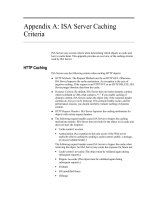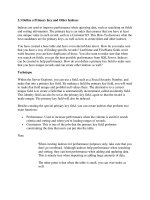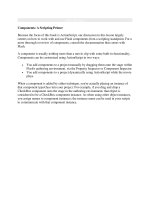Tài liệu Updating a Primary Key Value pdf
Bạn đang xem bản rút gọn của tài liệu. Xem và tải ngay bản đầy đủ của tài liệu tại đây (21.22 KB, 5 trang )
[ Team LiB ]
Recipe 4.8 Updating a Primary Key Value
Problem
You changed a primary key value in a DataTable and updated the change back to the
underlying data source, but the value in the data source remained unchanged. You need to
update a primary key value in the data source underlying the DataTable.
Solution
Use the SourceVersion property of SqlParameter to update the primary key value in the
data source.
The schema of table TBL0408 used in this solution is shown in Table 4-3
.
Table 4-3. TBL0408 schema
Column name Data type Length Allow nulls?
Id int 4 No
Field1 nvarchar 50 Yes
Field2 nvarchar 50 Yes
The sample code contains two event handlers:
Form.Load
Sets up the sample by creating a single DataTable containing an integer primary
key called Id and two string fields called Field1 and Field2. A DataAdapter is
created and the select, delete, insert, and update commands are defined for it.
Finally, the table is filled using the DataAdapter and the default view of the table
is bound to the data grid on the form.
Update Button.Click
Calls the Update( ) method of the DataAdapter defined in the Form.Load event to
reconcile the changes made, including those made to the primary key, with the
SQL Server database.
The C# code is shown in Example 4-11
.
Example 4-11. File: UpdatePrimaryKeyForm.cs
// Namespaces, variables, and constants
using System;
using System.Configuration;
using System.Data;
using System.Data.SqlClient;
private const String TABLENAME = "TBL0408";
private DataTable dt;
private SqlDataAdapter da;
// . . .
private void UpdatePrimaryKeyForm_Load(object sender, System.EventArgs e)
{
// Define the table.
dt = new DataTable(TABLENAME);
DataColumnCollection cols;
cols = dt.Columns;
DataColumn col = cols.Add("Id", typeof(Int32));
dt.PrimaryKey = new DataColumn[] {col};
cols.Add("Field1", typeof(String)).MaxLength = 50;
cols.Add("Field2", typeof(String)).MaxLength = 50;
// Create the DataAdapter and connection.
da = new SqlDataAdapter( );
SqlConnection conn = new SqlConnection(
ConfigurationSettings.AppSettings["Sql_ConnectString"]);
// Build the select command.
String sqlText = "SELECT Id, Field1, Field2 FROM " + TABLENAME;
da.SelectCommand = new SqlCommand(sqlText, conn);
// Build the delete command.
sqlText = "DELETE FROM " + TABLENAME + " WHERE Id=@Id";
SqlCommand deleteCommand = new SqlCommand(sqlText, conn);
deleteCommand.Parameters.Add("@Id", SqlDbType.Int, 0, "Id");
da.DeleteCommand = deleteCommand;
// Build the insert command.
sqlText = "INSERT " + TABLENAME + " (Id, Field1, Field2) VALUES " +
"(@Id, @Field1, @Field2)";
SqlCommand insertCommand = new SqlCommand(sqlText, conn);
insertCommand.Parameters.Add("@Id", SqlDbType.Int, 0, "Id");
insertCommand.Parameters.Add("@Field1", SqlDbType.NVarChar, 50,
"Field1");
insertCommand.Parameters.Add("@Field2", SqlDbType.NVarChar, 50,
"Field2");
da.InsertCommand = insertCommand;
// Build the update command.
sqlText="UPDATE " + TABLENAME + " SET " +
"Id=@Id, Field1=@Field1, Field2=@Field2 WHERE Id=@IdOriginal";
SqlCommand updateCommand = new SqlCommand(sqlText, conn);
updateCommand.Parameters.Add("@Id", SqlDbType.Int, 0, "Id");
updateCommand.Parameters.Add("@Field1", SqlDbType.NVarChar, 50,
"Field1");
updateCommand.Parameters.Add("@Field2", SqlDbType.NVarChar, 50,
"Field2");
updateCommand.Parameters.Add("@IdOriginal", SqlDbType.Int, 0, "Id");
updateCommand.Parameters["@IdOriginal"].SourceVersion =
DataRowVersion.Original;
da.UpdateCommand = updateCommand;
// Fill the table from the data source.
da.Fill(dt);
// Bind the default view for the table to the grid.
dataGrid.DataSource = dt.DefaultView;
}
private void updateButton_Click(object sender, System.EventArgs e)
{
// Update the table to the data source.
da.Update(dt);
}
Discussion
ADO.NET maintains up to three versions of each DataRow in a DataTable: the current,
original, and proposed. The current version is accessed by default. All versions can be
accessed using an overloaded DataRow indexer (C#) or an overload of the Item( )
property (VB.NET). Table 4-4
describes the different values of the DataRowVersion
enumeration.
Table 4-4. DataRowVersion enumeration
Value Description
Current
The current values in the row, representing the latest edits. This value is
always available.
Default
The default row version. If the row is being edited, this is the Proposed
version; otherwise it is the Current version.
Original
The original values for the row. Not available for rows that have been added
since data was last retrieved from data source or since AcceptChanges( ) was
last called.
Proposed
The proposed values for the row. Only available after BeginEdit( ) is called
for the DataRow( ) until EndEdit( ) or CancelEdit( ) is called.
To change the primary key in the table in the database, the UpdateCommand of the
DataAdapter needs to locate the row based on the original primary key and update the
primary key value with the current value of the primary key in addition to updating the
other row values with their current values. In the sample, this is done using the following
SQL update command:
sqlText="UPDATE " + TABLENAME + " SET " +
"Id=@Id, Field1=@Field1, Field2=@Field2 WHERE Id=@IdOriginal";
The primary key—Id field—is updated with the current value of the Id field, where the Id
field of the row matches the original value of the Id field.
The current value for the Id field is set with the following code:
updateCommand.Parameters.Add("@Id", SqlDbType.Int, 0, "Id");
The original value for the Id field is set by the following two lines of code in the sample:
updateCommand.Parameters.Add("@IdOriginal", SqlDbType.Int, 0, "Id");
updateCommand.Parameters["@IdOriginal"].SourceVersion =
DataRowVersion.Original;
The first line is the same as for the current version. The second line sets the
SourceVersion property of the parameter so that the original value for the Id field is used
when loading the value. The UpdateCommand correctly identifies the row to be updated
based on the original value of the Id field and updates the row with the current Id value.
Updating the primary key in a database is not normally necessary. Some RDBMSs do not
support updating the primary key. Additionally, if a data relation is based on the primary
key, related foreign key fields in the child tables will have to be updated to maintain
referential integrity.
[ Team LiB ]









